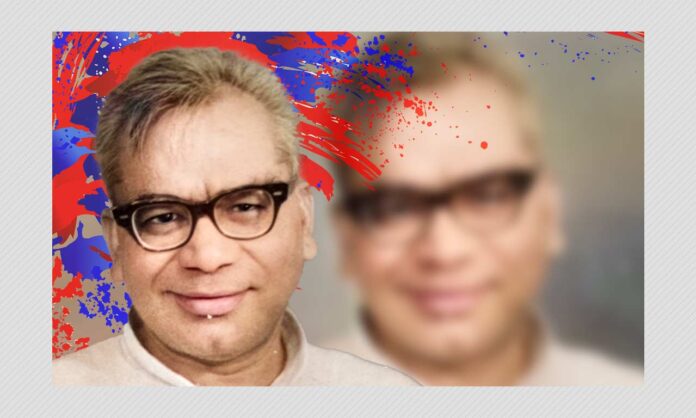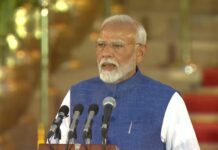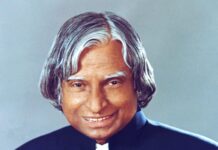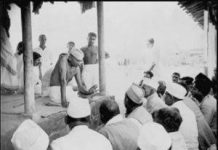— DINKAR SAKRIKAR —
It is sad that the worst philosopher is one who says ‘I told you so’. This indicates, if taken seriously a bias against foresight and vision. In an age of glorified mediocrities and inflated nonentities, anyone displaying vision and foresight is necessarilly despised and denigrated. Mediocrities can never tolerate a genius, cannot ever recognise vision and certainly cannot appreciate foresight which they themselves do not possess. It therefore becomes a crime to be a genius when mediocrities are in power.
Dr. Rammanohar Lohia is guilty of being blessed with vision and foresight. Even a cursory list of the “firsts” to his credit would indicate how he brought to the forefront issues which when he raised them were ignored or side tracked but were finally thrust upon the nation and had to be tackled in a desperate and, there-fore, inept manner, or were not tackled at all and therefore brought disaster on the country. He was the first and only Indian leader to support the Nepalese people’s revolt against Ranacracy. His activities in support of Nepal’s struggle were sowned upon by the then Prime Minister, but it was the Prime Minister who had to back-track upon his position on Nepal. King Tribhuvan was forced to join this struggle. The King had to be given shelter in the Indian embassy in Kathmandu. Again Dr. Lohia was the first to hold a conference of the people of the Himalayan region in a bold imaginative attempt to integrate border people with the rest of India. The attempt was ridiculed, its significance overlooked.
The price for this was paid in 1962, when China invaded this region and swept through it. Again it was Dr. Lohia who succeeded in forging a common link with the Japanese Socialist Party and the joint communique he issued with the Japanese Socialist Party leaders was the first (and the last) joint action by Indian and Japanese socialists. Apart from Government leaders, even his colleagues in the socialist movement did not grasp the opportunity offered by that joint communique with the result that Japanese Socialist Party soon passed under Chinese influence and adopted anti-Indian postures on Sino-Indian dispute. There are still a number of such issues of vital importance to India, to Afro-Asia and to the world which he has constantly sought to project. He was the first to predict the possibility of approximation of of world capitalism and world communism. At that time some wiseacres tried to ridicule the thought by distorting it as a theory of equidistance.
Actually, Dr. Lohia talked about equal irrelevance of the two systems to the developing nations and never once used the mathematical term equidistance The political tricksters had the audacity to teach the political scientist that mathematical equations do not work in politics. Now the trickster is exposed for what he is and Dr. Lohia’s theory of the equal irrelevance of communism and capitalism based on their growing approximation with each other stands vidicated by what is happening in the USSR and Eastern Europe and the growing collaboration between the two global powers.
Just for record let it be noted that he alone of all world thinkers has formulated the only rational solution to a peaceful world order by suggesting abolition of veto, universality of UN membership and a world parliament elected on adult suffrage. Nearer home he alone has offered the only possible solution to the Indo-pak conflict viz. an Indo-pak confederation. He alone has reminded Indians of their moral duty to support the struggle of the Pakhtoons, and has constantly exhorted them to be ashamed of India’s connivance at the Chinese ‘infanticide’ in Tibet. These policy-formulations are not the result of clever or smart political thinking. The difference between hint and his contempories is just this: while they depend on pragmatic approach to serve the moment Dr. Lohia’s vision enables him to perceive the future as a contimum of the past, history as a projection of geography, national interests as expres-sions of a coherent world-view. He is perhaps the only politician in India who knows India’s geogrophy as much as he knows Indian history, who knows as much about India’s culture and languages as he knows about world culture and languages. It is because of this depth and breadth of the knowledge of his own country and of the world that his forgen policy formulations possess an acumen absent in the thinking, such as it is, of many others on this subject.
Last year when Lin Pao wrote his new famous thesis of urban and rural areas of the world, the former developed, rich and imperialist, the latter undeveloped, poor and exploited and called for the encirclement of the urban by the rural masses, political commentators in the West suddenly became aware of a potential threat and a new challenge to Western power. Nearly ten years ago, speaking on ‘Foreign Policy” at Hyderabad Dr. Lohia had referred to this situation. He had then observed “In the past two hundred years, the world has been divided into the enormous town of Western Europe which manufactured commodities in factories and a much more enormous village of the rest of the world, which grows agricultural commodities.” This relationship has existed for two hundred years. Western Europe lives on this relationship but America and Russia have no need to do so. Therefore, Dr. Lohia suggests, there “is a great opportunity for America and Russia to understand not only that they are leaders of the world today but also that they have no stake in the world of yesterday, that they have no vested interest either in physical rule or in manufactured”. Upon the ability or inability of America and Russia to show this understanding towards the great village of Asia depends chances for peaceful solution of the major conflicts in the world. Even today this analysis of Dr. Lohia holds good and in fact points to the only possible line of action which the USA and USSR can follow to counteract the Red Chinese propaganda.
Dr Lohia is one politician who does not evade the question of race relationship and its impact on the world. In his characteristic blunt manner he says, “I want the peoples of this world to recog nise that the most vital and dominating and significant split in the world today is between the white and coloured peoples, that the white peoples own all the good things of this earth.” Dr. Lohia does not seek a reversal of this position, that is to say, to bring black people to the top. No, he says, “I do not want my country to sit on the top again. But I would want the coloured people to become equal with the white people.” For that, he says, facts as they exist must be recognised.
According to Dr. Lohia the most significant aspect of the European socialism has been its failure to understand these facts of world situation today and to evolve a world view which could deal with this situation. “European Socialists”, Dr Lohia observes, “are so much taken up with the problems of the moment, the statistical evidence and requirements of their own nation, that they miss the complete view and the world view. European socialism does not wish to face the fact that it is striving for plenty and equality in a small area amidst a world full of poverty and tyranny. This lack of a world view must force it always to be on the defen-sive, to lack elan, to make it go slow in its own areas and to have no answer for War and its Wasters”.
The basic content of this world view must be the concept of equality. All democratic documents of world history such as “The Declaration of Independence”, “The Declaration of the Rights of Man and Citizens”, “The Agreement of the People” or even the more ancient Funeral Oration of Pericles stressed the concept of equality. But even in twentieth century the concept has remained largely an inclusive concept with a preferential limitation encom-passing only citizens of a nation. Dr. Lohia believes that it is essential for the future of the world that the egalitarian idea be extended to nation. He is aware that “It is difficult for satified nations to contemplate economic and political equality with hungry nations”. But unless they do so “The world will be doomed to a state of poverty and war and increasing stagnation”. He says “The world and its nations need mutual assistance. Europe and the US have too much to conserve and too little to create, while Asia and Africa have too much to create but too little to build it on. Not the passing conflict of power blocs but this great war of our epoch determines man’s destiny. When Europe and US realise the impossibility to conserve, until Asia and Africa create, a world mind potent enough to form world government will have been born.”
This being the central point of his thinking on world situation it is not surprising that he remains almost alone in not being impressed by the shibboleths of Afro-Asian solidarity. This despite his insistence on what he calls “the frontiers of skin colour. the rich and the powerful white as against the coloured poor and weak.” This is not, he emphatically states, “a plea for a combination of coloured peoples.” Hs does not believe nor does he propagate such a combination because he has always denied “a single Asia or Africa.” He talks of three Asias, the Asia of chaos of communism, and the Asia of conservation or capitalism and feudalism. His only modification of this classification is the admission that the “Asia of change or socialism has not yet come into being in any effective way. What is mas-querading in its place is the Asia of corrupt pseudo-leftism”.
But even this statement was made in February 1963. Although it is still very much applicable to India it would be interesting to know that Dr. Lohia has to say about the Asia of change that has developed in UAR or Burma. However, reverting to the main issue “coloured combination”, Dr. Lohia believes, “irrespective of idcologies, have always been a sham”. This has been proved by the fiasco of the second Bandung Conference and the disruption largely due to Sino-Soviet conflict of the Afro-Asian solidarity Organisation. Dr. Lohia asserts that “any coloured combination to achieve equality with the white peoples is therefore devoid of value”. What then is the way to bring about the equality between the white and the coloured? Dr. Lohia answers it equality between the white and the coloured may be achieved by “a combination of all those who desire equality, irrespective of their skin colour”. (The Chinese Communists despite their fierce passion for equality seek a combi-nation of only those who have the same skin-colour i.e. of the non-white). In achieving this equality the US and the USSR hold the key position. That is why Dr. Lohia has repeatedly suggested that these two powers should come together not only for the narrow and limited purpose of seeking relaxation of tensions or tensions of nuclear disarmament of various degrees but for a wider purpose of “destruction of poverty, for achievement of parity between agri-cultural and industrial prices, for increasing equality between the white and the coloured”.
This statement of Dr. Lohia offers the most clear, the most definite and the most concrete exposition of the aims which India’s foreign policy should seek to achieve in world politics. There is no loose, abstract sentimental talk of peace and co-operation, of brotherhood of man and equality of nations but a very precise almost clinical formulation of policy objectives.
The world role which Dr. Lohia prescribes to India is a projection of this world view. For him the ‘acid test’ of India’s foreign policy is whether Free India is becoming “a maker of world peace and prosperity, if not its prime creater”. As he sees it freedom of India has made no difference to the world and its ways. He recognises that to the extent that free India was weak in armour and industry she “would have been in any event, displaced from the centre of world affairs. But ideas are at least as potent a tool in foreign policy as steel, and the constructs of a new world repose as much in men’s minds as in the weapons which their hands wielded”. After the revolution Bolshevik Russia attempted to construct a new world and that made her foreign policy effective despite her weakness in armour and industry. India’s “displacement from the creative centre of the world stage” is not so much due to her military or industrial weakness but due to “the immeasurable poverty of ideas” and “the refusal to take risks for a new hope at home and abroad”. Dr. Lohia believes that “India should…follow an independent and creative policy.” What are the ingradients of this “independent” and “creative” policy?
On the world plane the policy must stay the twin dangers of hunger and war’. He advocates a ‘positive two-fold policy of world parliament and world government on the one hand, and world Development on the other”. This is in sharp contrast with the official policy of relying on verbal panegyries of peace without any definite ideas about how to promote it. More especially, the Indian policy has never so forcefully projected either the issue of world poverty or the responsibility of the rich ‘white’ nations for it. A foreign policy to be meaningful must in the first place be “sustained by internal achievements and creation of raw strength”. He believes that the practice of democratic socialism can alone secure the entire Asian region stretching from Cairo to Jakarta ideologically and economically while “a series of mutual assistance pacts would provide it some armed security”. The basic cause of the ineffectiveness of India’s foreign policy has been that it never had any such concrete objectives to persue or a definite programme to follow. Therefore Indian Government could show no initiative and could only react favourably or otherwise to what others do. “The India Government rarely acts; it only reacts”.
Nowhere is the truth of Dr. Lohia’s criticism so painfully demonstrated as in India’s failure to secure firm relationship with her immediate neighbours such as Pakistan or Nepal or even her sensitive border areas like Urivasiyam (NEFA). Dr. Lohia was the only national leader who since as far back as 1950 repeatedly warned the Government against their policy of neglect and indifference towards border areas. Despite these warnings “these people and the regions have been deliberately kept soft, as a standing invitation to foreign aggressor”. The Urvasiyam, an area of 30,000 sq. miles was kept “in cold storage, insulated from any further development, with its people eternally condemned to the primitive stages of life”. In Sikkim the people have not yet been given the right to elect their own government. If Nepal is not vulnerable today as it once was, it is because a popular struggle once took place and some kind of a popular democratic govern-ment was invaded Indian passivity did a great harm to Tibet, the world and to India herself. However, Dr. Lohia does not merely offer this pungent criticism of India’s frontier policy but has given to the country positive alternatives to follow. He would for insta-nce accept the McMohan Line if Tibet is free but as China has made Tibet forcibly a part of China, the Indian border will have to be drawn by Kailash and Mansarover with India. The border areas occupied by China must be taken back without much delay. Tibet must become free. It must be clearly understood that a positive foreign policy can be built only when our friends and neighbours are made strong. A strong Nepal, a free and strong Tibet and strong Sikkim and Bhutan are essential for India’s national safety.
Dr. Lohia’s views on various issues of Indian foreign policy as well as on world problems have been outlined in his numerous speechies and writings These have been compiled and brought together in a volume. Dr. Lohia’s views on foreign policy and international politics have acquired a special significance in view of his own pivotal role in Indian politics and in view of the dramatic changes in India’s political pattern. This volume therefore deserve a careful study by all students of international politics.

















